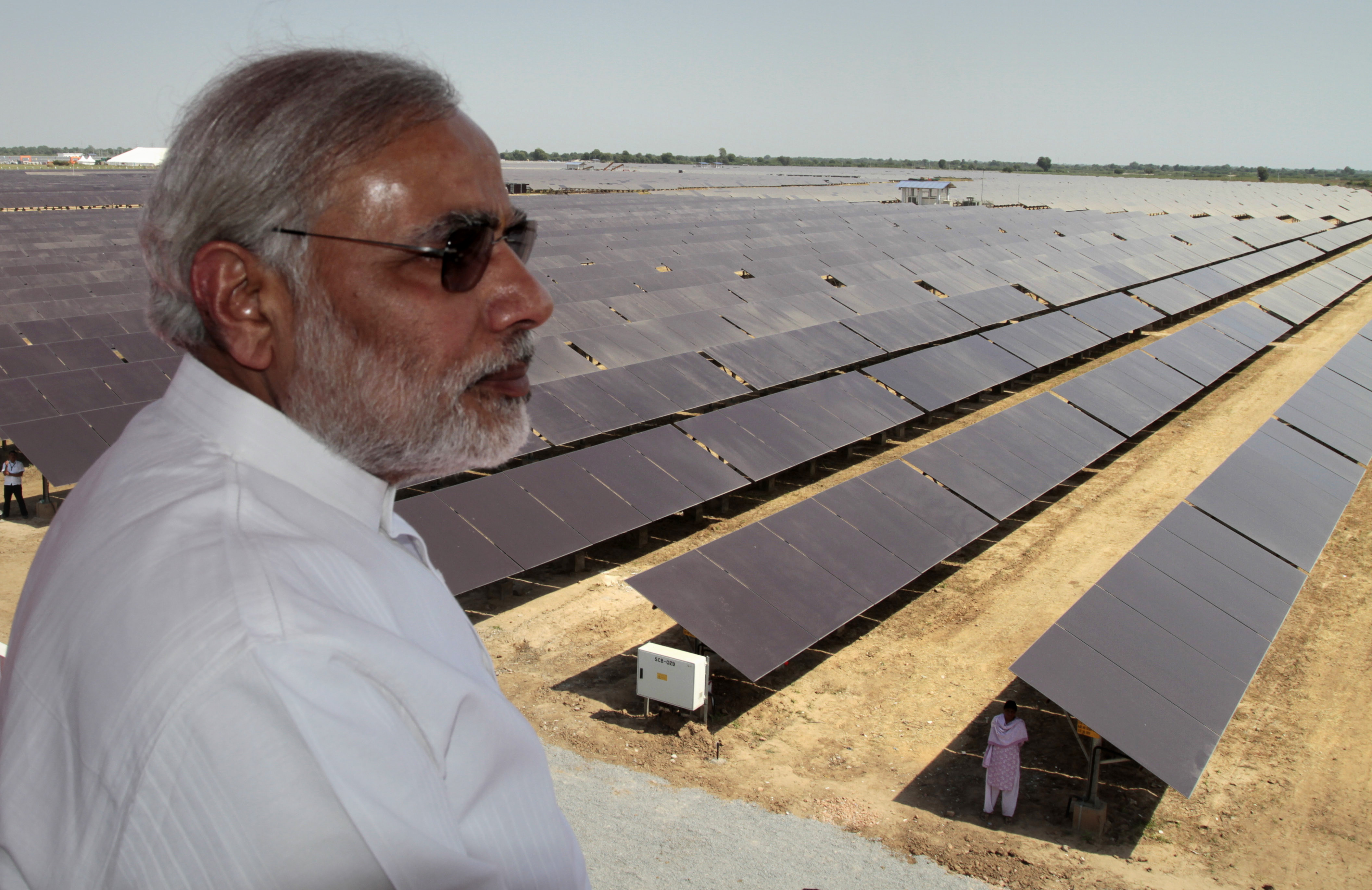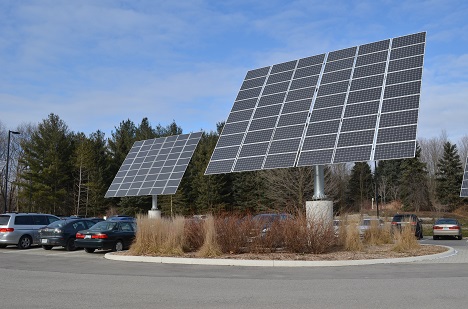From Russia with solar energy

Narendra Modi overlooks the panels at a solar energy farm at Gunthawada in Gujarat state in 2011.
APAlmost 400 million people in India do not have access to electricity, while some remote places in the country experience power cuts for over 20 hours daily. With around 300 days of sunshine in a year, India is considered among the best places in the world to harness solar energy.
The Government of India is taking multiple steps to achieve India's ambitious renewable power production target of 175 gigawatts (GW) by 2022, for which the country would need over US$ 200 billion in investments. This includes addition of 100 GW of solar power, 60 GW of wind energy, 10 GW of power from biomass and 5 GW from small hydro-power projects. The country has already crossed a mark 26.8GW of wind and 7.6 GW of solar power installed capacity by May, 2016, according to Ministry of New & Renewable Energy (MNRE) data.
On the solar energy front, the government is trying to make solar projects economically viable and ensure that bankability and returns are reasonably assured for investors. India’s target for reaching 100 GW of solar power by 2022 assumes that 40 GW will come from rooftop solar projects and another 40 GW from large-scale projects. The remaining 20 GW is to come from ultra-mega solar power projects - solar parks, each with a minimum 500 MW capacity. MNRE has sanctioned over 30 parks with a capacity of about 19 GW in 21 states.
Over the past three years, according to MNRE data, the renewable energy sector has attracted over $14 billion, with the solar power segment receiving around $4.5 billion. “A lot of foreign investors, including US-based companies, Asian companies, European companies are participating in India’s solar market, especially in the central government’s projects where the share of international players now is about 50%,” said Jasmeet Khurana, associate director – consulting at ‘Bridge to India’.
Most of the projects are located in Western and Southern India. “States like Rajasthan, Gujarat, Tamil Nadu, Madhya Pradesh are the largest states in terms of total installation,” he said.
‘Bridge to India’ expects India to become the fourth largest solar market globally this year, overtaking the UK, Germany and France. With 25 GW of projects under different stages of development and about 35 new tenders with a cumulative capacity of 15.5 GW announced last year, and an additional 5 GW of new tenders to be announced in the coming months, the market is growing at an exponential rate, experts say.
Global majors like US-based SunEdison, Japanese SoftBank Corp., Italy’s Enel Green Power, French EDF Renewable Energy, Finnish Fortum Corp. as well as Indian players, including Welspun Renewables Ltd, Goldman Sachs-backed ReNew Power Ventures and Morgan Stanley-owned Continuum Wind Energy Ltd, Leap Green Energy, NuPower Renewables and others are actively expanding in India despite certain challenges that the solar sector is facing. Land availability and cost, drop in tariffs at which solar power projects are awarded from Rs. 12 per unit in 2010 to less than Rs.5 per unit in 2016, and issues with power evacuation are among those challenges.
Russian entry
Cooperation between Russia and India in the energy sector is on the rise, and though more evident in sectors like oil, gas and nuclear power, the renewable sector is slowly gaining momentum. While Russia has participated in several hydropower projects across India, including the 3,750MW Upper Siang II project in Arunachal, Teri hydropower plant in Uttaranchal and 60-MW Balimela hydroelectric project in Orissa, the promising solar sector is lagging behind.
“Russia and India can co-operate in the field of renewable energy through exchange of technology, investment in the sector and companies participating in each other’s countries. Discussions for projects keep taking place time to time. However, no concrete project so far has been set up,” Tarun Kapoor, Joint Secretary in the MNRE, told RIR.
The Russian Energy Agency (REA) and Solar Energy Corporation of India (SECI) have signed an MOU for several large-scale solar photovoltaic (PV) power plants in December 2015. The initial pilot project of up to 500 MW is, however, just at “initial planning stage”, the spokesperson of The Russian Ministry of Energy (Minenergo) said.
Private players have proven more active in tapping India’s solar energy sector. Alok Kumar, CEO of Moscow-based Akis Tech Ltd and Delhi-based President of Miyota Power India, said the Indian solar power sector provides plenty of opportunities for foreign investors. Miyota is currently developing several project opportunities in India and Bangladesh with a total estimated capacity of almost 500 MW. For these projects, MIYOTA is partnering with Russian investors as well as solar-cell and modules manufacturers and technology providers.
MIYOTA has, over the past few years, signed a joint investment contract with Russian Minneftegasstroy for investing in a portfolio of up to 60 MW of solar power in India. The company has signed agreements with Russian Hevel group, a joint venture between Renova Group and OJSC Rusnano, for joint co-production of solar PV panels for Indian market, and with Russian Solar Management Group for co-investments in solar power projects in India. In March, 2016, the company signed an MOU with the government of Haryana state for 100 Mw grid connected solar power project with investments of $ 90 million.
“The land acquisition process is currently underway”, Kumar said.
Printing for energy
Dmitry Lopatin, a Russian scientist from Krasnodar in southern Russia, found India a perfect place for manufacturing of solar panels and equipment. Lopatin made headlines last year when he was charged with the illegal acquisition and exportation of psychotropic substances on a large scale (which could result in 11 years jail sentence) after he ordered a can of solvent from an online store in China to use in his experiments on a new kind of solar panel. The charges were dropped later.
An inventor of printable solar cells that are more efficient and cost less than existing ones, Lopatin is now setting up a facility in India to manufacture industrial printers to print the solar cells. Initially, Lopatin considered manufacturing solar cells in India, but he realized that making printers here would be more effective. He has registered a company in India, Nanoprint, and is now in the process of signing contracts with two institutional investors from Russia and Australia.
“We are not dropping the idea of manufacturing cells, but it will be done in some time, and most probably, with a new pool of investors,” Lopatin told RIR. He was earlier in talks with Tata Power Solar to set up a plant in India. This has not resulted in any agreement yet.
“India has good infrastructure and resources to start a new company or manufacturing, and it definitely requires less financial resources, compared with US, for example,” Lopatin said. “However, the consumer demand for solar energy in India is not yet as big as in the US or in European countries, although the overall requirement for solar energy is huge”. He said printers manufactured by Nanoprint in India will most likely be exported to other countries than sold within India.
The young scientist and his team have also developed a membrane for water purification, which could be used for solving India’s water crisis. The membranes can be printed on the same printer as solar cells.
All rights reserved by Rossiyskaya Gazeta.
Subscribe
to our newsletter!
Get the week's best stories straight to your inbox


